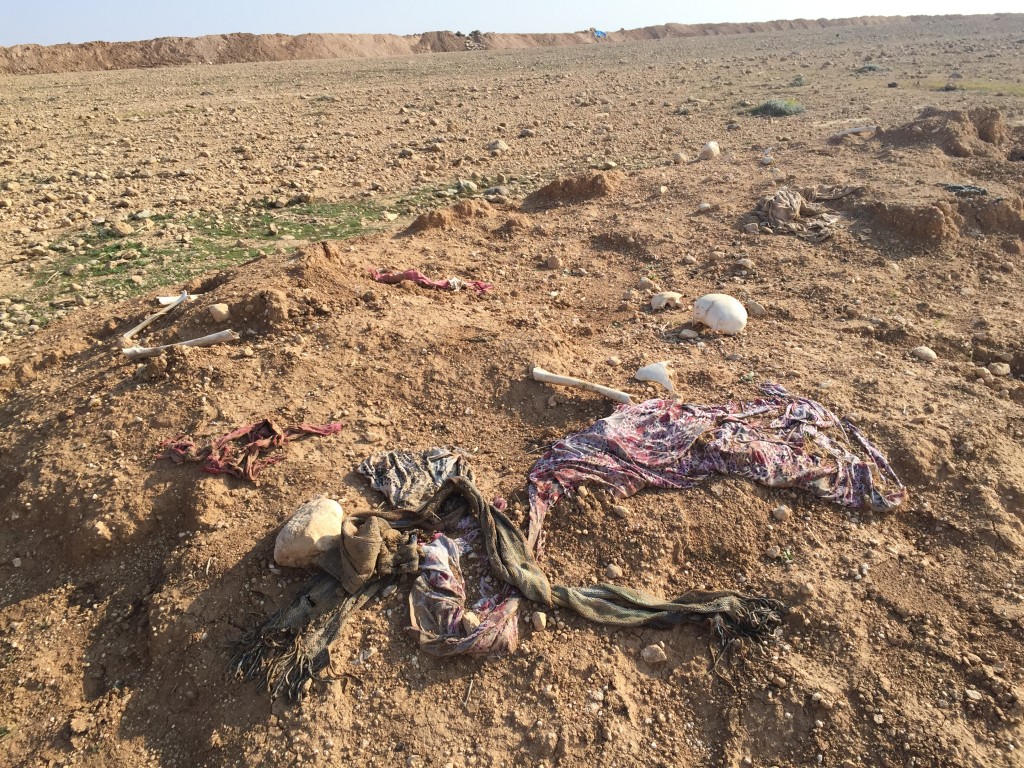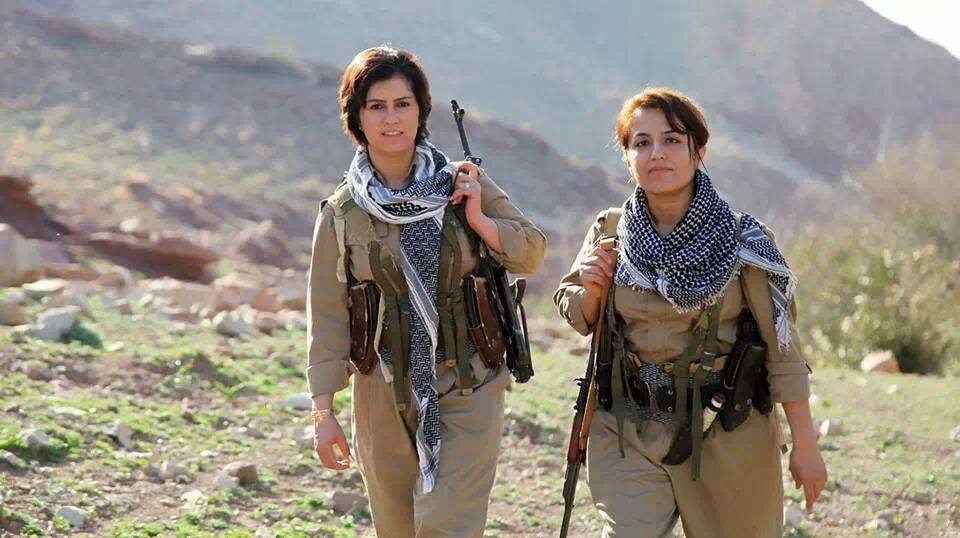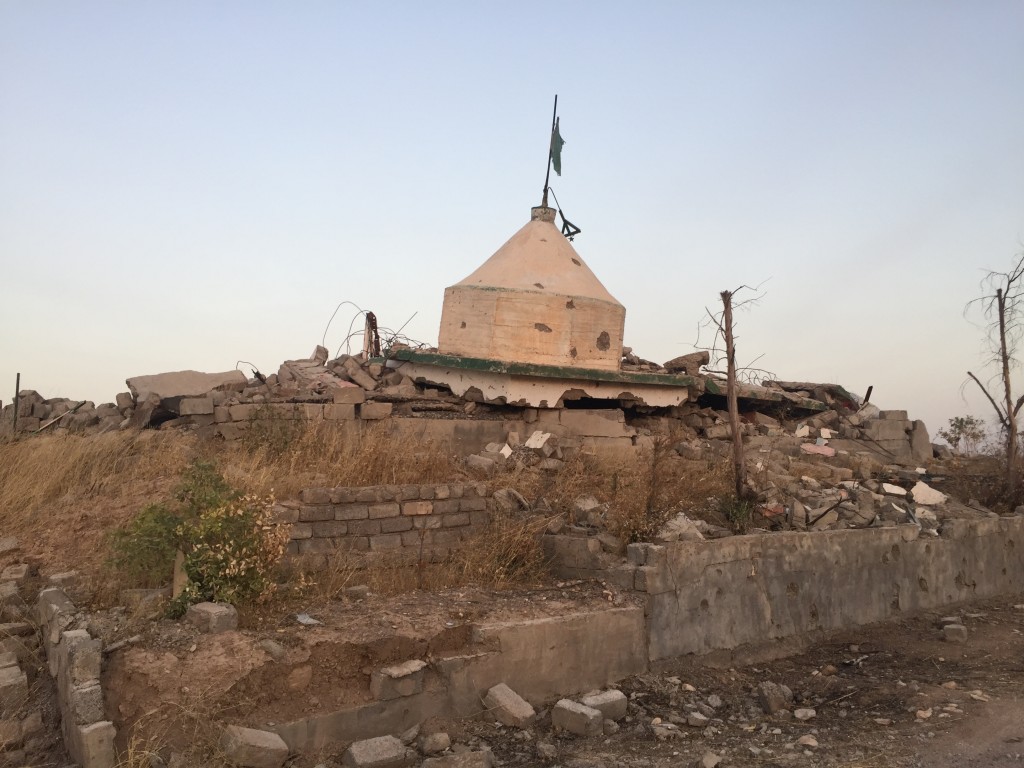by Seth J. Frantzman
Hat tip: Dr. Jean-Charles Bensoussan
Of all of the groups to try to defeat ISIS, the Kurds of Iraq have been the most effective—and have done so while championing gender equality and religious pluralism. So why don’t they have more Western support?
A poster-sized calendar in Arabic lies on the ground outside the steel door of a family compound in northern Iraq. It is marked “2013” and shows a strange collage of tall gleaming buildings, a mountain with a sunrise, and snow. The message is one of happiness and serenity. In 2016 it still sits, almost like new, near rubble that is suspected of being laced with explosives set by the Islamic State.
Sitting on a flat plain next to the Khazir River, the village of Wardak is mostly deserted today. The village was a home to the Kakei, a small religious minority, numbering around 75,000 in Iraq, who worship an ancient and secretive faith. In late May, Wardak was liberated from ISIS control by the Kurdish Peshmerga, the armed forces of the Kurdistan Regional Government (KRG) in northern Iraq. In 2009, the village was targeted by an al-Qaeda truck bomb, part of a wave of terror attacks that year that killed hundreds of Christian, Shabak, Kakei, and Yazidi minorities around Mosul. Before ISIS launched a surprise attack on the area in August 2014, the Kakei never suspected that the war in Syria or the chaos in Iraq would lead to their being forced to flee all their villages.“Some Kakei families were in Mosul and they fled to Peshmerga lines,” recalls Habeb Kakei, a local leader. “At midnight, when ISIS attacked, people began running towards Erbil,” the capital of the KRG. Ten thousand people fled overnight on August 3. The mass exodus was a continuation of the ethnic cleansing ISIS had already committed against Christians in Mosul in June. Like the Kakei, Assyrian Christians in northern Iraq are an ancient indigenous community dating back almost 2,000 years. In June 2014, ISIS forced them to flee from the Nineveh plains where they numbered around 40 percent of the local population. Nonetheless, the Kakei and the Christians were luckier than the Yazidis, another indigenous religious group, which ISIS subjected to genocide and mass slavery.
In visits to the mass graves of Yazidi victims in Sinjar in December 2015, and to Kakei villages in July of 2016, what I saw was striking. Not only had a modern genocide—of culture, religion, and people—been committed by the Islamist extremists, but there had also been an awakening among Kurds and other minority groups, who now recognized the need to defend minorities from extremism.
One can’t help but see parallels with the Holocaust in the way ISIS targeted minorities. It was not spontaneous butchery, like a pogrom, but a well-planned operation. ISIS declared groups such as Yazidis to be “kaffirs”—unbelievers—divided men from women, and sold the women into slavery. They even lured villagers into a false sense of hope, telling them to convert to Islam before slaughtering the men and elderly women, and putting younger women on buses bound for slave markets in Mosul and the ISIS capital of Raqqa.
Just as families were separated at Auschwitz before being led away or Jews in Ukraine were forced to dig their own graves, Yazidi men were taken to trenches dug with bulldozers and machine-gunned. ISIS broadcast the videos triumphantly. Today one can find the AK-47 and M-16 bullets that struck the men. Skulls with bullet holes can be seen in the mass graves, exposed by rain over the last two years, the bones bleached by the sun. Around 20 mass graves have been found so far, and 3,500 Yazidi women and children are still held as slaves by the Islamists.As in all the places where ISIS targeted minorities, the victims found shelter among the Kurds, who are predominantly Sunni Muslims. In the last two years, the Kurdish Peshmerga has created units for minority volunteers. They include more than 1,200 Kakei men, thousands of Yazidis, and Christians who fight as part of the Nineveh Plains Forces and other Christian units. Every minority in the region has taken up arms to fight ISIS, and many have formed their own units in the Peshmerga, holding sections of the frontline against the enemy.
The Kakei know that the evils of Islamist extremism didn’t begin with ISIS, but percolated for a decade. “Many people were targeted after 2003, and in December 2004 a holy place was blown up [by terrorists],” recalls Habeb. “In September 2009, al-Qaeda sent two vehicles full of gas and TNT [to] blow up Wardak village.” He shows us how the trucks laden with explosives tried to navigate a bridge over a stream. A local Kakei man and his friends used small arms to disable the truck and one of the older men boasts that he killed the al-Qaeda driver. A silver .45 is tucked into his vest, perhaps the same one he used. Despite the men’s attempts to defend their village, 20 people were murdered and 140 injured. In 2009, the locals built trenches around their villages to defend against jihadists. “The international community and Europe should recognize what happened to us as a genocide,” says Habeb. “There were Christians and Shabak who lived here, and Turkmen. We lived peacefully together and share frontlines together and we have a common enemy in Arabs and terrorists.” Habeb wants his villages to be part of the KRG and protected by Kurdish forces.
Inside the villages that have been recaptured, ISIS left behind mines and explosives. The idea was not merely to destroy the minority religious sites there, which were dynamited, but to cause maximum casualties when people returned. Tunnels stretching 2,000 meters or more were found by Peshmerga de-mining teams. As I peered into one tunnel in the living room of a house, into the pitch black that smelled like rot and death, an older Kakei man nodded and said, “It’s like Gaza, like Hamas.” When I was in Shingal in December 2015 with Kurdish de-mining teams, they also referenced Gaza as an example of the use of terror tunnels against civilians.
There is a general sense among the various minority groups in Kurdistan that their war against jihadists is similar to what is happening in Israel. There is a great deal of respect for Israel’s fight against Islamist terror, and recognition that what was done to the Jews has now been visited upon the Kurds and other minorities. In the 1980s, when Saddam Hussein was planning attacks on Israel, he was also committing the Anfal genocide against the Kurds, in which 4,000 villages were damaged and up to 180,000 people murdered. Saddam used the same poison gas on Kurds with which he threatened to “burn Israel” in 1991.
Minority groups in Kurdistan greatly respect Israel’s fight against Islamist terror, and say that what was done to the Jews has now been visited upon the Kurds and other minorities.The commander of a Peshmerga unit, when asked which country he feels the Kurds are closest to, references Israel. “We think Israel is our closest friend in the struggle,” he says. “We have a common history.” A woman in the same room notes that the relationship between Jews and Kurds dates back to the Persian Empire and the time of Xerxes I, the emperor often referenced in the story of Esther. Persians suppressed Jews and Kurds, so they formed a common bond.
Indeed, for decades, Arab nationalists, Islamists, and the Iranian regime have described the Kurdish struggle in terms of Israel. On July 21, for example, former Iranian Foreign Minister Ali Akbar Velayati was reported to have claimed that the U.S. was “plotting to establish a second Israel in the region” in the form of a free Kurdistan. Opposition to racism, genocide, and the feeling that both Iran’s mullahs and extremists in the Arab world have targeted Kurds as a “second Israel” have cemented a unique bond with the Jewish state, and with the idea of preserving the kind of regional diversity that Israel represents.
These sentiments have been carried out in practice. Kurdish groups such as the Democratic Party of Iranian Kurdistan (PDKI), which oppose the Iranian regime, collaborate with other oppressed minority groups such as Azeris and Balochis. In Iraqi Kurdistan, one can see Christian churches and Yazidi temples, as well as many ethnic and religious groups living side by side. Without Peshmerga protection, these groups would have been slaughtered or expelled by ISIS. “We don’t trust the Iraqis anymore, we want to be a part of Kurdistan. We are a special minority group and jihadists do not accept us and they think they have a right to kill us. But we have a good relation with Christians,” the Kakei leader said.
Most Yazidis agree. They say they don’t trust the residents of Arab villages and towns such as Tal Afar that border their region and are under ISIS control. Survivors recall how they saw men who had once been their neighbors eagerly raping and selling women after ISIS came. There were too many willing executioners. Christians feel the same way. Qaraqosh was once home to 50,000 Christians and is now deserted. Ancient Christian monasteries such as Mar Behnam have been blown up by the extremists. Some have begun to believe that those who eventually return to the Nineveh plains will be returning to a land forever changed by destruction and death. One can’t help but think the same of those Jews pondering a return to Poland or Germany after the war.
North of the frontlines on the Nineveh plains, the temperatures climb to more than 110 degrees. It’s an unbearable oven, even for locals, who sometimes get the day off due to the heat. Near Mosul Dam, around 50 km from the Syrian border, there is a small checkpoint for traffic. This area was liberated from ISIS in mid-August, one of the first areas to be re-taken after ISIS launched its August 3 offensive. The dam is a strategic asset, and in the hands of extremists would have posed a threat to the inhabitants living downriver.
Today, little has changed since the liberation. Frontline bunkers lie in the distance where the war has been relatively static for almost two years. Occasional mortars fall on one of the checkpoints. Blackhawk helicopters apparently operated by U.S. Special Forces aiding the Kurds ferry operators to a mission in the distance.On a hill overlooking the road, a group of Syrian Kurdish women who have joined a Peshmerga unit are busy guarding the area. Because of the complex politics between Kurdish groups, this unit, which is affiliated with the ruling party of the KRG, cannot operate in Syria, where the Kurdish regions are dominated by the Democratic Union Party of Syria, a group that is close to the Kurdistan Workers Party, which usually operates in Turkey. Regardless of politics, however, these women have joined thousands of Kurdish women who have gone to war against ISIS over the last two years.
Sitting in the female commander’s office, Capt. Gulestan Yusuf Ahmed discusses her role as a Kurdish woman defending her nation. “Having women serve, it changes the image of women in society,” she explained. “We prove to everyone that women can run a house and run a country. In the past Kurdish women also joined and took part in revolutionary movements, but we now prove it for the whole community.”
The role of women in Kurdish society, and particularly the Peshmerga, is in complete contrast to the fate meted out to women by ISIS and Islamist extremists in the region. At a Kurdish checkpoint in Makhmur, the closest to the Iraqi army’s frontline against ISIS, there were dozens of refugees fleeing ISIS-controlled areas. The women were happy to be rid of the all-black clothing ISIS imposed on them. They described stories of being kept at home by ISIS religious police, persecuted just for going to buy a tomato.
The same contrast can be felt among Iranian Kurds from the PDKI. At a secret training base, men and women train together so they can return to Iran and fight the regime. In the last few months, the PDKI has stepped up attacks against Iran’s Revolutionary Guards. The women say that fighting the regime on behalf of Kurdish rights is only one motivation. They are also fighting for women’s rights. In a country where religious police harass women who don’t cover their hair, seeing young Kurdish women in uniform, their hair flowing in the wind, is a powerful image.
In a region beset by increasing religious extremism and dictatorial regimes, the Kurds have carved out a safe space for women and minorities. They face a tough enemy in ISIS and a complex future as they navigate the intricate relationships between them and the Arab world, Iran, and Turkey. Economic problems and the need for direct financial and military support from the West endanger the hard-fought rights they have obtained.
And yet, they are fighting ISIS with the same zeal that helped blunt the Islamist drive for dominance in Iraq and Syria in 2014. On August 14, more than 5,000 Peshmerga emerged from their trenches and swept over 150 square kilometers near Gwer and the Khazir River. They demolished ISIS defenses, killing around 120 extremists. Footage showed one Kurdish man, wounded in the face, saying he wouldn’t accept medical treatment until he’d killed at least two of the enemy.American support for the Peshmerga, some of whom haven’t been paid in months because of budget crises, is finally coming through after the U.S. signed an agreement to fund the Kurds directly, rather than go through Baghdad. The question is whether this funding and the gains the Kurds have made will continue after ISIS is eliminated from Mosul, or whether the West will abandon the Kurds as it has in the past.
There has been a tendency in the current U.S. administration to work with countries such as Iran, where “death to America” is an annual chant at events, while spurning countries and people who admire America. There is also a tendency to feel more sympathy for those extremists willing to kill for their beliefs than for their innocent victims.
The Kakei men in Wardak know what it is to be innocent victims. They continually expressed the feeling that they are hated for no reason. “Our religion believes in unity and we respect others. We never did anything to others and never hurt others,” said one man. “The jihadists do not accept us and they think they have a right to kill us.” Here is a perfect example of diversity and multiculturalism threatened by the most extreme form of intolerance in the world, and yet the West, which claims to stand for diversity and freedom, has not stood by the Kakei or other minorities in the Middle East. It’s easier for an ISIS member to get into Europe than a refugee fleeing ISIS, and incidents in refugee centers in Germany and on the Greek island of Leros show that Yazidis continue to be attacked by jihadists even on European soil.
In Kurdistan, the West has a chance to stand by its values, supporting not only diversity, but also standing with Muslim Kurds who are fighting ISIS and have been the most effective force against the extremists. But among those like Secretary of State John Kerry who continually preach that “ISIS is not Islam,” there is a startling degree of disinterest in supporting Kurds. Instead, Western countries work too closely with Baghdad, where the government remains close to Iran and whose Shia militias espouse a sectarian intolerance that is not very different from ISIS. The test in Kurdistan will be whether Western states can stop making excuses and paying lip service to their declared values, and instead invest in rebuilding communities of religious minorities, commemorating the Yazidi genocide, and aiding the Kurds.
Seth J. Frantzman
Source: http://www.thetower.org/article/why-the-kurds-should-fascinate-western-liberals/
Follow Middle East and Terrorism on Twitter
Copyright - Original materials copyright (c) by the authors.



No comments:
Post a Comment